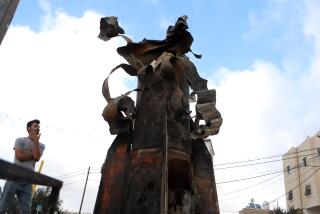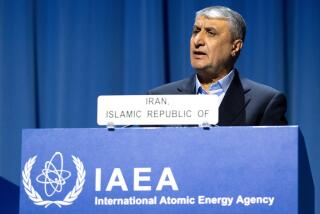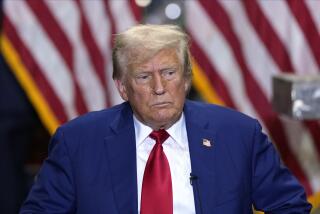Iran Determined to Get A-Bomb, U.S. Believes : Arms: Officials say Tehran is using Chinese technology in a long-term effort to develop weapons.
WASHINGTON — Although a recent inspection found no evidence of nuclear weapons research, U.S. officials believe that Iran is engaged in a determined, long-term effort to develop nuclear weapons with the help of technology from China.
Over the last few years, China has provided Iran with technology similar to that used by Iraq’s Saddam Hussein in his program to develop nuclear weapons. Beijing also furnished Iran with a mini-reactor and other items useful for nuclear weapons research.
“I don’t think the Iranians are going about it in such a brutish fashion as Saddam Hussein,” one State Department official said. “Their program is much more subtle and long-term.”
Iran now ranks, along with North Korea and the Commonwealth of Independent States, among the top concerns of U.S. officials worried about the spread of nuclear weapons.
CIA Director Robert M. Gates testified in Congress last month that Iran “is building up its special weapons capability as part of a massive . . . effort to develop its military and defense capability.” He said that Iran is looking to China to supply missiles and nuclear technology.
China contends that all of its nuclear help to Iran has been above-board and that the facilities it is helping Iran develop comply with the legal safeguards of the International Atomic Energy Agency.
A Chinese Foreign Ministry spokesman said last November that while China has supplied Iran with nuclear technology, it is “only for peaceful purposes.”
But U.S. sources said the Bush Administration recently has urged China at “very senior levels” to stop helping Iran’s nuclear program.
“We’re trying to tell the Chinese that in this case, you’ve got to go beyond the letter of the law (the IAEA safeguards),” an Administration official said.
From Feb. 7 to 12, four inspectors of the IAEA toured six Iranian nuclear facilities and found no evidence of a weapons program. “The activities . . . were found to be consistent with the peaceful application of nuclear energy,” the international agency said in its report.
But the IAEA report noted that its conclusion that Iran’s purposes are peaceful was limited to the sites visited by the team and only for the specific six-day period of the inspectors’ visit. U.S. officials said the agency’s report was very carefully worded and does not contradict their view that Iran has embarked on a plan to develop nuclear weapons.
“These courtesy visits (by the IAEA) do not have the same standing as a special inspection,” said one U.S. official. In a special inspection, the agency has the right to ask to see whatever nuclear facilities it wants, on short notice. By contrast, the recent visit by the IAEA team toured only sites arranged, in advance, with the government of Iran.
Further, U.S. officials say there is substantial evidence that Iran is interested in such techniques as the enrichment of uranium and reprocessing of plutonium--steps that are not needed for civilian nuclear purposes but are important for developing nuclear weapons.
In 1990, Iran and China signed what was then called a 10-year agreement for scientific cooperation and the transfer of military technology. The pact was signed after Iranian President Hashemi Rafsanjani met with a visiting official from China’s Council of Science and Technology, the Chinese organization responsible for nuclear programs.
As recently as last June, China officially denied that it was providing Iran with any nuclear technology.
And, at least in public, Administration officials accepted China’s explanations without challenge. Deputy Secretary of State Lawrence S. Eagleburger testified before the Senate Foreign Relations Committee last June that there was no evidence that China was helping Iran’s nuclear program.
Over the last six months, however, U.S. officials have begun to acknowledge in public that China is supplying nuclear technology to Iran.
Over the same period, Chinese officials themselves have begun to admit the existence of this nuclear cooperation.
China’s Foreign Ministry confirmed last November that Chinese and Iranian companies “signed commercial contracts . . . in 1989 and 1991” for China to supply Iran with “an electromagnetic separator for producing isotopes and a mini-type reactor, both of which were to be used only for peaceful purposes.”
The separator for producing isotopes is similar to the calutron technology that was used by Iraq. That primitive technology, which can be used to make nuclear weapons fuel, was employed in the Manhattan Project.
U.S. officials said that these publicly acknowledged items are, by themselves, “very small-scale stuff” and could not be used by Iran to make nuclear weapons. But they said that the Chinese exports would be invaluable for an Iranian nuclear weapons program, because they would help Iran acquire the know-how with which to later build nuclear weapons.
They also noted that Iran has shown an interest in developing the fuel for nuclear weapons and that Iran’s vice president said publicly last year that all Muslim countries should try to obtain nuclear weapons.
“They (Chinese officials) are sending Iran the components. . . . This gives them (Iran) a leg up in understanding the basic technology,” one State Department official explained. “It is the kind of technology that, over time, the Iranians might be able to master and use for nuclear-weapons purposes.”
Gary Milhollan, a specialist on nuclear weapons for the Wisconsin Project on Nuclear Arms Control, said that China’s sale to Iran of a mini-reactor for nuclear research is particularly troubling.
“I think that exporting research reactors is nuts,” Milhollan said. “We’ve had so many bad examples in the world in the past. . . . If you know how to run and maintain a research reactor, then that’s the first step toward building a larger one.”
He noted that India, Israel, Iraq and Pakistan used research reactors from abroad as a first step in developing nuclear weapons.
More to Read
Sign up for Essential California
The most important California stories and recommendations in your inbox every morning.
You may occasionally receive promotional content from the Los Angeles Times.










